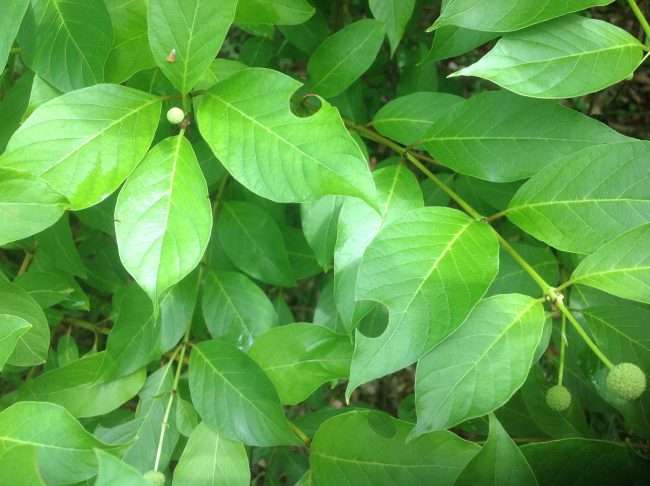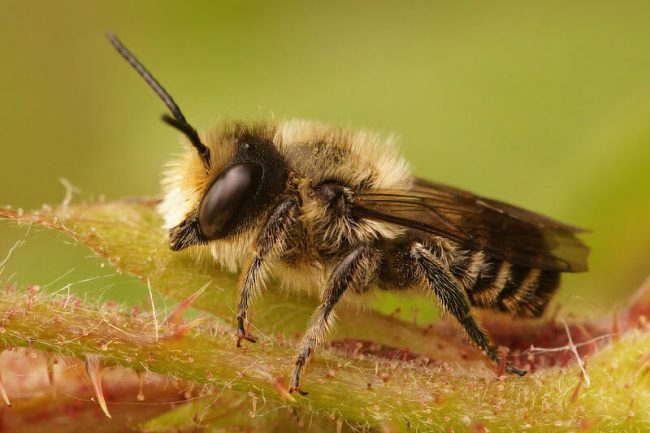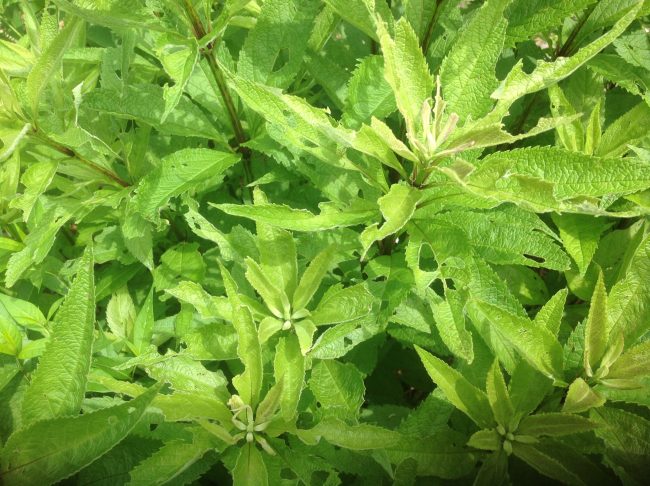Yes, this time of year we often see some leaf damage courtesy of some garden friends and garden foes (as well as hail!). Holes are not necessarily a reason to panic and pull out the insecticide sprayer. In fact, they can be an indicator that your ecosystem is healthy and functioning as it should.

The circular holes above in our native buttonbush at the Teaching Garden are from a native leafcutter bee. Leafcutter bees are small- to mid-sized bees that are about ¼ – ½ inch long. There are several species here. They are often especially hairy in appearance. Leafcutter bees are in the family Megachilidae (Greek for “big lip,” because of their big, toothed mandibles). The females use these mandibles like scissors to cut out beautifully rounded discs of leaves that they use in lining nest chambers for their eggs. Leafcutter bees nest in pre-existing holes in wood created by other insects or in hollow plant stems. Many other species nest underground, but leafcutter bees do not. They are solitary bees, in other words, they don’t nest in colonies like bumblebees and honeybees. Females nest individually, although many females can nest in the same general area if they find the right nesting material. Unlike many female bee species, which gather and pack pollen into a structure on their back legs (which is called a pollen basket, or more correctly, corbicula) and the pollen is partly held in place by long hairs called scopa, leafcutter bees collect pollen in structures on the underside of their abdomen. So if you see a bee with a fuzzy yellow underside, it might be a leafcutter bee, or other species that carry pollen that way including carder bees, mining bees and mason bees in our area.

Patchwork leafcutter bee https://beeprofessor.com/megachilidae-bee-family/
A great place to get more information on Wisconsin bee species is the Wisconsin Bee Guide. It has photos and information on 13 common bee species. https://hort.extension.wisc.edu/files/2016/08/WI-BEE-IDENTIFICATION-GUIDE.pdf
If you really want to geek out about bumblebees, there is a great forum, the Wisconsin/Midwest Bumble Bee Observers on Facebook. They are prolific posters, so if you want to see lots of bumblebee photos, join citizen science projects and generally get really great information, it’s the place for you! https://www.facebook.com/groups/555238811914604/
Many of our beleaguered pollinators can only feed their young the pollen from a narrow range of native plants. Where they nest and what plants they feed on is very complicated and closely related to their life cycle, the type of proteins, amino acids and lipids the pollen provides, the structure of the flowers collected from (ex. long-tongued bees can access flowers short-tongued bees cannot), how close the flowers are to the nest, what type of soil or cavity or plant stem they like to next in and so on. You can give bees all the nectar sources you want, but if they don’t have the right kind of pollen to collect for their young, they still can’t reproduce. Many bees are pollen specialists. They might only feed on the pollen of a single plant species. They may feed on only a single genus of plants, for example, goldenrods or a few related genera of plants. And some are more generalist pollen feeders/collectors that can feed their young pollen from multiple plant families. So their habitat might be very restricted, trying to match up suitable nesting sites/nesting materials with nearby appropriate plants in sufficient quantities
Now on to other holes in leaves. In general, holes result from the feeding of various caterpillars and beetles. While I am not fond of the feeding of non-native insects like the spongy moth, Japanese beetle and viburnum leaf beetle, I do want to encourage you to consider tolerating some feeding by native insects.

This is one of our nativar joepye weeds in the Teaching Garden. By the way, why is it that so many of our native plants are referred to as ‘weeds’? Butterfly weed, joepye weed, and sneezeweed to name a few.
Even though there are obvious holes in the leaves, if you stand back, you will notice that what you see is still primarily green. In other words, yes, there is feeding, but other than the aesthetics, nothing else is really affected. The plant is not severely harmed or defoliated. I have spent a lot of my career advising people to plant species that don’t get fed upon by caterpillars; mostly non-natives. I am now re-thinking that advice. I am now planting and advising the planting of plant species bearing leaves and flowers that CAN and SHOULD be eaten and/or pollen fed upon. We are currently in a biodiversity crisis. We need all of our native insects many of which are the basis of the food web (especially caterpillars) to serve as pollinators for different plants, and to serve as food for birds, mice, amphibians, other insects, snakes and more.




